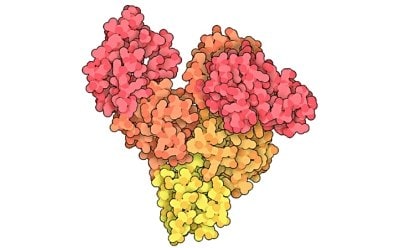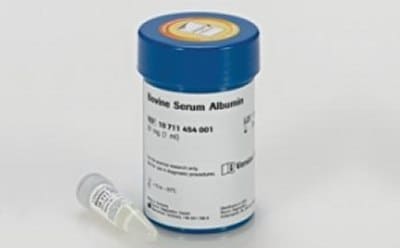Albumins and Transport Proteins

Many molecules are unstable or insoluble when they exist in non-complexed forms. In vitro, albumins and other carrier proteins are often used to bind, sequester and stabilize a range of important small molecules and proteins. Albumins are simple water-soluble proteins found in animal fluids and tissues, and to a lesser extent in plants. Albumins are used in the biomanufacture of therapeutic monoclonal antibodies and recombinant proteins.
We provide albumins for comprehensive application needs, including cell culture, protein quantitation, enzyme stabilization, ELISA, and antibody-related processes. Along with albumins from diverse sources, we offer these essential proteins in different formats and formulations.
Products
Products
Albumins in Cell Culture
Albumins, particularly from bovine serum (BSA) are an important component of many serum-free cell culture systems, particularly those that utilize hybridoma or Chinese Hamster Ovary (CHO) cells. In cell culture media, albumin functions by binding and delivering other essential molecules to cells in culture. Because all albumins do not have identical efficacy in culture media, it is advisable to choose those that have been tested for cell culture applications.

Bovine serum albumin (BSA) is a globular protein (~66 kDa MW) that is used in numerous biochemical applications due to its stability and lack of interference with biological reactions. The BSA structure is a single polypeptide chain consisting of about 583 amino acid residues and no carbohydrates. Learn more about the BSA protein structure, BSA molecular weight, properties, and applications in our BSA physical properties and application guide.
BSA is the classic workhorse of albumin products used in numerous applications. Our diverse formats for albumin from bovine serum include purities ranging from 95-99%. We manufacture and distribute BSA purified from a variety of primary methods including the true Cohn fractionation method, modified ethanol fractionation methods, heat shock, and chromatography. Additional purification steps may include crystallization or charcoal filtration. For convenience, our BSAs are defined by method of preparation:
- Chromatographic purification of albumin typically yields a more highly conserved native protein conformation than the ethanol and heat shock fractionation methods.
- The ethanol and heat shock method combine both processes using Cohn fractionation to perform the initial purification followed by a heat step to further purify the albumin to ≥ 99% by Agarose electrophoresis.
- Ethanol fractionation is a fractionation method that includes the adjustment of ethanol concentration, pH, and temperature. Unlike the heat shock method, this process is kept at a low temperature ensuring a non-denaturing condition for the proteins and preserves the native albumin structure and function.
- The heat shock fractionation process of heat and pH adjustment relies on the addition of a protein stabilizer. This addition allows the albumin to tolerate the increased temperature of > 65 °C. Most other plasma proteins denature and precipitate during this process yielding an albumin with increased purity.
Human Serum Albumin (HSA)
Human serum albumin (HSA) is the most abundant protein in human plasma with a molecular weight of ~66 kDa (based on amino acid composition). Serum albumin may be referred to as Cohn Fraction V. This naming convention is taken from the original Cohn method of fractionating serum proteins using cold ethanol precipitation, as serum albumin was found in the fifth ethanol fraction using Cohn’s method. Since then, the term "Cohn Fraction V" has been used by some to describe serum albumin regardless of the method of preparation. We produce human serum albumins using a cold alcohol fractionation process derived from the traditional Cohn method, as well as from the heat shock method, and offer both native and recombinant versions of HSA in powder and solution formats.
Other Albumin Products
Our portfolio includes additional albumin products for specific applications requiring human and other nonbovine proteins. Recombinant human albumins and animal component-free (ACF) albumin are supplied in aqueous buffers or lyophilized powder formats. Albumins available from other species include those derived from the following sources:
- chicken egg white
- mouse serum
- rat serum
- porcine serum
- ovine serum
Our albumins are of high purity and superior solubility to ensure low background in protein quantitation assays, and to minimize interference in bioprocesses.
Transferrins and Transferrin Replacements
Cells require iron to bind available oxygen from the extracellular environment. Transferrins are single chain glycoproteins found in serum that facilitate the uptake of iron in culture medium and its subsequent intracellular transport. Although transferrin is the physiologically optimal method for delivering iron to cells in culture and has therefore been integral in the production of biopharmaceuticals such as monoclonal antibodies, lower-risk animal-free systems have led to some adoption of small-molecule alternatives to transferrin in biomanufacturing. Many of these transferrin alternatives are iron chelators, which must be used with appropriate protocols in culture systems as many do not manage redox cycling of iron and can therefore contribute to oxidative stress. Our cell culture reagents include a complete selection of transferrins and transferrin replacements.
Related Resources
- Albumin in Cell Culture
Explore serum albumin's role in serum-free cell culture systems for biomanufacturing.
To continue reading please sign in or create an account.
Don't Have An Account?